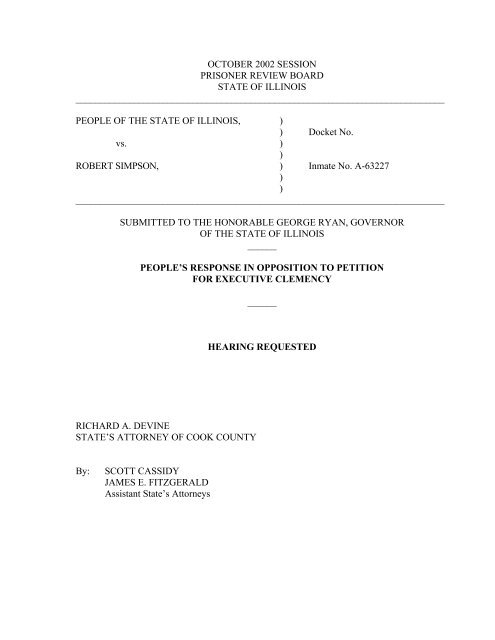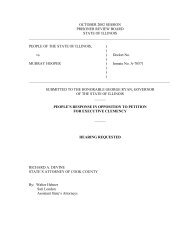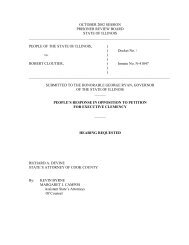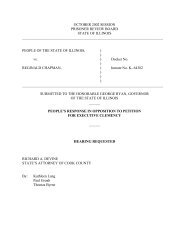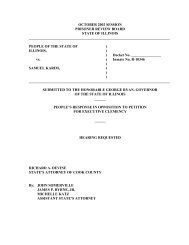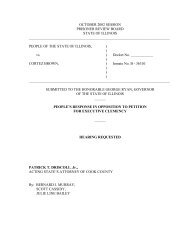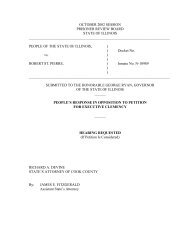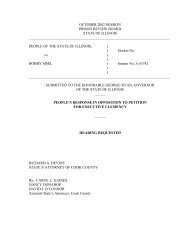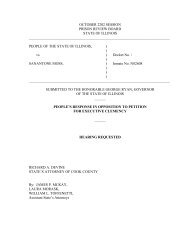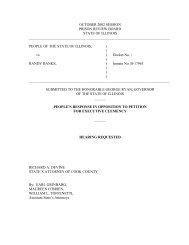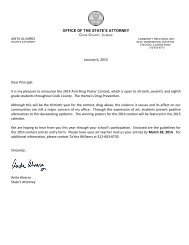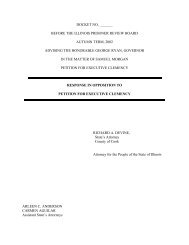Robert Simpson - Cook County State's Attorney
Robert Simpson - Cook County State's Attorney
Robert Simpson - Cook County State's Attorney
You also want an ePaper? Increase the reach of your titles
YUMPU automatically turns print PDFs into web optimized ePapers that Google loves.
eing made by defendant and not by the Public Defender's Office. (R. 7) The matter wassubsequently continued by agreement for tendering of discovery. (R. 10) Prior to continuing thecase, the trial court tendered to defense counsel a copy of the case of People v. Myles, 86 Ill.2d 260,427 N.E.2d 59 (1981), with instructions to allow defendant to read it. (R. 10)On the next court date, defendant announced to the trial court that he was representinghimself. (R. 16) The trial court advised defendant that in its opinion, he would be making a mistakeif he chose to represent himself and informed defendant that the Public Defender's Office wouldcontinue to represent him until a determination was made upon the issue of whether he would bepermitted to represent himself. (R. 17) The trial court stated that in the event that defendant exercisedhis constitutional right to represent himself, it would appoint Mr. Frank Rago, an Assistant PublicDefender, to act as standby counsel. (R. 18) Defendant informed the court that he was demandingimmediate trial. (R. 22) The matter was subsequently continued by agreement for a hearing todetermine whether defendant would proceed pro se or retain counsel. (R. 36)At the hearing, held on August 12, 1992, the trial court noted that it had previouslyappointed the Public Defender's Office and asked defendant if he understood that it was his right toproceed pro se or retain counsel. (R. 36) Defendant stated that he understood and that he was readyfor trial. (R. 36) The trial court cautioned defendant that it would be unwise for him to representhimself, noting that the case against him appeared complex and that there was a possibility thatdefendant could receive the death penalty. (R. 37) The trial court advised defendant that in the eventhe elected to represent himself, the law would treat him as an attorney and he would receive nospecial consideration. (R. 37) The trial court inquired whether defendant had spoken to AssistantPublic Defender Rago about the case and if defendant wished to see him before making a decision.3
he wanted to represent himself and defendant responded each time that he was ready for trial. (R. 42)The trial court advised defendant that it would inform him of the charges he faced, thepotential penalties involved and his rights under the law. (R. 42-43) Accordingly, the trial court readto defendant each of the eight counts he was charged with and explained the possible penalties foreach of the offenses. (R. 43-51) The trial court specifically advised defendant that if it were proventhat defendant committed first degree murder during the course of a felony, the People could requestthat defendant receive the death penalty. (R. 47) The trial court explained in detail the two phases ofthe death penalty hearing, and advised defendant that in the absence of mitigating factors, the courtwould be required to impose a death sentence. (R. 47) The trial court asked defendant if heunderstood the charges against him and the possible penalties involved, and defendant replied that hedid. (R. 45-46, 51) The trial court asked defendant whether he still wished to give up his right to alawyer and defendant replied that he did, "if that's what it takes to go to trial." (R. 46, 51)Defendant again expressed his dissatisfaction with the fact that each time he was in court, adifferent attorney appeared who was not sufficiently familiar with his case. (R. 52) The trial courtreplied that Assistant Public Defender Rago, who had handled many serious cases such asdefendant's, was well-versed in the law, knowledgeable as to the appropriate motions to be filed andwould represent defendant throughout the pendency of the case as lead counsel. (R. 52-53) The trialcourt stated that defendant's attorney was willing to represent him to the best of his ability but thatdefendant's counsel was asking for a continuance in order to assess the case. (R. 54-55) In short, thetrial court summarized, defendant's attorneys were informing the court that they could not effectivelyrepresent defendant without further investigating the case, and the trial court would not compel them5
to proceed. (R. 53) The trial court advised defendant that if he wished to disregard his attorney'sadvice and wished to represent himself, the court would permit him to do so. (R. 54) Once again, thetrial court asked defendant if he wished to represent himself. (R. 54) Noting that his counsel was notready for trial, defendant stated that he wished to represent himself. (R. 54)Explaining that defendant was not entitled both to represent himself and have an attorneyrepresent him, the trial court explained the role of standby counsel. (R. 53-54) The trial court statedthat standby counsel was an observer, who would undertake the role of representing defendant shouldit ever become necessary to remove defendant from the courtroom. (R. 53-54) The trial court statedthat it did not wish to convey to defendant a false sense of security in the concept of standby counsel,however, because defendant would still be considered to be representing himself. (R. 54-55)"Sounds fine," defendant replied. (R. 54) The trial court asked defendant if he understood that hehad a legal right to have a lawyer represent him and that this right could not be taken away withouthis consent. (R. 55) Defendant stated that he understood. (R. 55)The trial court advised defendant that he had the right to hire his own lawyer and that if hedid not have the funds to do so, the court would appoint a lawyer to represent him without cost. (R.56) Defendant stated that he understood. (R. 56) The trial court explained that an attorney wouldadvise defendant about such matters as what plea to enter, whether to elect a bench or jury trial andthe presentation of witnesses. (R. 55) The attorney would work with defendant in the preparation ofa defense, would question witnesses, argue to the court or jury as well as discover and present theapplicable law. (R. 55-56) Again, defendant stated he understood. (R. 56) The trial court askeddefendant whether he had any questions about anything the court had told him and defendant repliedthat he did not. (R. 56) The trial court inquired whether, knowing everything that the court had said,6
defendant still wished to give up his right to an attorney. (R. 56) Defendant stated that he did. (R.56) The trial court inquired as to defendant's level of education and whether he would have anyproblem researching the law. (R. 56-57) Defendant replied that he believed he was competent andthat he was ready for trial. (R. 57) The trial court asked whether defendant wished to representhimself, and defendant replied that he did, further stating that he wanted a jury trial and a date. (R.57) Accordingly, the trial court appointed Assistant Public Defender Rago as standby counselpursuant to People v. Myles, supra, and advised defendant that he could consult with him. 2 (R. 57)The trial court stated its belief that defendant understood his rights under the law and thepenalties involved. (R. 57) Defendant confirmed that he understood what he was giving up. (R. 57)The trial court then expressed its belief that defendant had freely and voluntarily entered into hisdecision, and defendant confirmed that this was true. (R. 58) Defendant stated, however, that hewas "forced" into proceeding pro se because no one was taking the time to inform him of "what wasgoing on." This way, defendant stated, he would know what was going on and, accordingly,demanded a trial date. The trial court stated that it was simply attempting to determine whetherdefendant's decision to represent himself was, in fact, his decision and again asked whether he wishedto represent himself. Defendant replied that he did. The trial court found that defendant's decisionwas freely and voluntarily entered into, and, accordingly, allowed defendant to exercise his right ofself-representation. (R. 61)The case was continued to the following day, at which time the trial court again inquiredwhether defendant still wished to represent himself. (R. 89) The trial court advised defendant to2 On a subsequent court date, at defendant's request and in order to facilitate discovery, the trial court entered an orderdirecting Mr. Rago and the Public Defender's Office to act as investigators on defendant's behalf, provided that defendant'srequests were not unreasonable. (R. 211)7
econsider his decision, a decision the trial court stated was unwise. (R. 90) The trial court notedthat, although defendant had a constitutional right to represent himself, it had never personallyobserved a pro se defendant achieve a favorable result at trial. (R. 91) The case was subsequentlypassed in order for defendant to confer with standby counsel Rago. (R. 92) When the case wasrecalled, defendant stated that he wished to continue to represent himself. (R. 95) The case wasthereafter continued. 3On the next court date, the trial court stated that it had previously advised defendantagainst representing himself and inquired whether defendant had changed his mind. (R. 103)Defendant confirmed that he still wished to represent himself. (R. 103) The trial court informeddefendant that it was still willing to appoint counsel to represent defendant and cautioned him that itmay not be inclined to do so in the future if defendant requested an attorney on the eve of trial as partof a strategy. (R. 103) Defendant stated, "yes sir," and subsequently requested a trial date. (R. 103,124) Accordingly, the case was continued for trial. (R. 124, 128)(2). Motion to Suppress IdentificationOn November 30, 1992, defendant filed a motion to suppress identification. (C.R. 149-153) A hearing on the motion was held on May 20, 1993. (R. 587) In his motion, defendantessentially contended that his pre-trial identification by witnesses had been impermissibly tainted bythe fact that the witnesses had seen his picture in television news media reports prior to identifyinghim in a lineup. (C.R. 149, R. 591-592) Defendant also contended that the lineup was impermissibly3On a subsequent court date, at defendant's request, the trial court ordered standby counsel Rago to conduct interviewswith certain identification witnesses pursuant to discovery (R. 202-203), and further ordered the Public Defender's Officeto act in an investigatory capacity on behalf of defendant and at defendant's direction. (R. 210-211)8
suggestive for various reasons (C.R. 152), including the fact that he was the only subject with a curlin his hair. (R. 703)Sergeant DiMare testified that he had been assigned to investigate the instant offensewhich had resulted in the death of the victim, Barbara Lindich. (R. 595-596) Pursuant to hisassignment, Sergeant DiMare contacted several witnesses in the early morning hours of May 26,1992, and asked them to come to the Glenwood Police Department in order to view a lineup. (R. 595-596) Sergeant DiMare informed the witnesses that the purpose of the lineup was to determinewhether the witnesses could identify anyone who had been present in the Fairway store on May 20,1992, the date of the offense. (R. 595) An officer was stationed at the front lobby of the policestation and instructed to ensure that, as each witness arrived, he or she was not to speak with anyother witness. (R. 597) Sergeant DiMare stated that, to his knowledge, the witnesses did not havecontact with each other prior to their viewing the lineup. (R. 603, 605, 607, 608)Just prior to the witnesses' arrival at the police station, Sergeant DiMare had a conversationwith defendant in the room in which the lineup was to take place. (R. 597-598) Sergeant DiMareinformed defendant that he did not have the right to refuse to be in a lineup, but that he did have theright to have an attorney present for the same. (R. 598) Sergeant DiMare further informed defendantthat he could choose to stand in any of the five positions in the lineup. (R. 598-599) Defendant chosethe third position and told Sergeant DiMare that the other men could be positioned in any manner.Defendant did not request that an attorney be present for the lineup. (R. 599) By 1:30 a.m., thecontacted witnesses, Kathryn Koszut, Ruth Morford, Angela Fields, Helen Gair and KimberlyKnight, had arrived at the police station. (R. 596) Sergeant DiMare testified that the followingprocedure was employed with respect to the witnesses viewing the lineup. First, each witness was9
individually escorted from the lobby area of the police station to an office adjoining the roomcontaining the five men participating in the lineup. (R. 600, 601, 603, 605, 607, 608) Next, thewitness viewed the lineup through a glass window separating the two rooms and attempted to makean identification. (R. 600) After viewing the lineup, the witness was escorted into a separate office,away from the witnesses waiting in the lobby who had yet to view the lineup. (R. 602-603, 605, 606-607, 608) Before each new witness viewed the lineup, Sergeant DiMare advised defendant that hecould elect to change his position in the lineup and that he had the right to have an attorney present.(R. 604, 606, 607, 608-609) Each time, however, defendant elected to remain in the third positionand declined to have an attorney present. (R. 604, 606, 607, 608-609) All five witnesses who viewedthe lineup identified defendant. (R. 602, 605, 606, 608, 609) Sergeant DiMare testified that, to hisknowledge, none of the witnesses had been shown photographs of defendant, had seen his likeness ontelevision or in the media, or seen him in a one-on-one show up prior to their viewing the lineup. (R.614-615) Sergeant DiMare further testified that neither he nor any other officer ever suggested to anyof the witnesses whom they should identify in the lineup. (R. 615)The lineup photograph was introduced into evidence at the hearing. (R. 693, S.R. Vol. 1)Referring to a lineup report he had previously filled out, Sergeant DiMare testified as to the physicalcharacteristics of the men portrayed in the photograph. (R. 609-612) According to the informationlisted in the lineup report, the men ranged in height from five-foot-nine to six-foot-one and in weightfrom 144 to 225 pounds. (R. 609-612) Defendant himself stood five-feet-eleven inches tall andweighed 179 pounds. (R. 611-612)The parties stipulated that if the witnesses listed in certain police reports were called totestify at the hearing, they would testify consistently with those reports. (R. 649-650, 687) The first10
eport was an incident report containing a narrative describing the general manner in which themurder occurred. The next 12 reports were interview summary reports dated May 20, 1992, the dateof the offense, containing summaries of observations of the shooting and the offenders made byvarious witnesses, including those who identified defendant at the lineup. In these reports, defendantis described as a black male ranging in age from 30 to early 40's and in height from six feet tall to sixfoot-two.4 The final set of reports reflected the fact that defendant was identified without hesitation inthe lineup held on May 26, 1992 by witnesses Kathryn Koszut, Ruth Morford, Angela Fields andKimberly Knight.The trial court found that there was no evidence that any of the witnesses who identifieddefendant had seen defendant's likeness in media reports prior to viewing the lineup and characterizedas speculative defendant's contention to the contrary. (R. 708-709) Regarding defendant's contentionthat the lineup was unnecessarily suggestive because he was the only subject with a curl in his hair,the trial court examined the lineup photograph and noted that the other men also appeared to havecurls in their hair although not as large as defendant's. (R. 709) The trial court found that anyargument regarding the curl would go to the weight of the lineup identification but that the lineupitself was fair. (R. 710) Accordingly, the trial court denied defendant's motion to suppressidentification. (R. 710)Defendant then filed a motion for appointment of standby counsel other than the PublicDefender. (R. 727) In support of his motion, defendant contended essentially that the PublicDefender's Office, standby counsel Rago in particular, were not providing him with sufficientassistance in obtaining discovery. (R. 727-735) Defendant further contended, inter alia, that the4 Sergeant Dimare testified that defendant was 39 years old. (R. 612)11
Public Defender's Office was not doing enough to obtain evidence and prepare a defense on hisbehalf. (R. 730)The trial court reminded defendant that he could not legally represent himself and yet besimultaneously represented by counsel. (R. 738) The trial court further reminded defendant that ithad previously informed him that if he chose to represent himself, he would be acting as his ownlawyer and would have the responsibility for making his own decisions. (R. 739) The trial courtrecalled that when it appointed Mr. Rago as standby counsel, it advised defendant that the only reasonfor the appointment was in the event that defendant did not conduct himself properly and had to beremoved from the courtroom. (R. 739) Noting that it had admonished defendant pursuant toSupreme Court Rule 401 and that defendant was now acting as his own lawyer, the trial court statedthat it was not required to appoint standby counsel at all, but had done so for its previously statedreasons. (R. 741) The trial court advised defendant that he was free to consult with Mr. Rago shouldhe so desire but that he was not required to do so and could conduct his own case as he had beendoing. (R. 741) However, the trial court stated, not having observed any misconduct on the part ofMr. Rago, it would not remove him as standby counsel. (R. 740-741) Accordingly, the trial courtdenied defendant's motion for appointment of alternative standby counsel. (R. 742) Upon denial ofthe motion, defendant demanded trial. (R. 743) The case was continued for trial. (R. 747)(3). Motion to Quash ArrestOn May 27, 1993, a hearing was commenced on defendant's motion to quash arrest. (C.R.182-185, R. 803) Before the hearing, standby counsel Rago informed the trial court that defendanthad filed a complaint against him with the <strong>Attorney</strong> Registration and Disciplinary Commission. (C.R.256-260, R. 750) Defendant again renewed his motion for appointment of alternative standby12
counsel, claiming that Mr. Rago was not performing an adequate investigation in the case. (C.R. 258,R. 759, 763) The trial court reminded defendant that he had demanded trial, an indication that he wasready to proceed. (R. 759) However, the trial court noted, defendant was now informing the courtthat he was not ready to proceed, an indication that he had misrepresented his position and wasattempting to inject error into the record. (R. 759-760) The trial court stated that it would address theissue presently and asked defendant whether he had any additional motions. (R. 767) Defendant thenfiled a motion for substitution of judges, citing the trial court's "prejudice and racism attitude." (R.767-768) Defendant's motion was transferred to and denied by the Honorable Thomas J. Condon.(R. 783) The trial court then again denied defendant's motion for the appointment of alternativestandby counsel and the matter proceeded to a hearing on defendant's motion to quash arrest. (R. 797,801)Prior to proceeding on the motion, defendant clarified that his contentions were that therewas no valid consent given to search the apartment in which he was arrested and that there was noprobable cause for his warrantless arrest. (C.R. 182-185, R. 801) Defendant later confirmed that hewas also requesting suppression of any evidence recovered as a result of the alleged illegal arrest andsearch. (R. 1524)Alexander DiMare and Barbara Schmidt testified for the People on defendant's motion.Defendant called Rich Goode, Thomas Schilling, Van DiCarlo, Thomas Rowan and <strong>Robert</strong> Sliwa.Glenwood Police Sergeant Alexander DiMare testified that on May 25, 1992, pursuant tohis murder investigation, he learned that fingerprints taken from the crime scene had been establishedto belong to a woman named Carolyn LaGrone. 5 (R. 804-805) Because LaGrone's physical5 One of defendant's co-defendants.13
description on file was consistent with the description given by witnesses of one of the offenders inthe store at the time of the shooting, the police interviewed LaGroan later that same day. (R. 805)LaGroan told police that on May 20, 1992, she, defendant and a woman named LurlarnYoung 6 went to the Fairway store for the purpose of committing an armed robbery. Young remainedoutside in the car while defendant and LaGroan went inside the store. The two announced a holdupand defendant, who was armed, struck the cashier in the head with his pistol. While removingmoney, defendant shot the victim, Mrs. Lindich, in the neck. LaGroan and defendant then fled thestore with the robbery proceeds, consisting of cash and checks, and drove off in Young's car. (R.806) As the three drove through the city, they ripped up the checks and threw them out of the carwindow. Defendant and Young dropped LaGroan off at her home, giving her $40.00 for herparticipation in the robbery. (R. 807)Sergeant DiMare testified that an alert was put out for Young's vehicle and, also later thatday, she was taken into custody. (R. 824-825, 831) After being advising of her Miranda rights,Young informed the police that she knew both defendant and LaGroan and that she believed the twohad been involved in an armed robbery. (R. 807, 809) Young informed the police that she lived at anapartment located at 14015 Stewart, in Riverdale, Illinois with her daughter and, on occasion,defendant. (R. 811, 823) Young's personal identification confirmed that she resided at the aboveaddress. (R. 841) Young further informed the police that the lease to the apartment was in her nameand that she paid the rent. 7(R. 823) Young then gave police permission to search the6 Defendant's other co-defendant7 One of defendant's witnesses, <strong>Robert</strong> Sliwa, testified that he was the owner of the building located at 14015 Stewartand that on May 25, 1992, the apartment in question was leased to defendant and Lurlarn Young. (R. 1646) When showna copy of a lease to the apartment by defendant, Mr. Sliwa identified the signatures of defendant and Young affixedthereto. (R. 1650)14
aforementioned apartment and executed a written consent to search form. (R. 810-11) The form waspublished and admitted into evidence. (C.R. 284, R. 813-814) Young also gave police her housekeys. (R. 816)Sergeant DiMare testified that defendant's physical description, obtained from defendant'scriminal history, was consistent with information he had previously obtained. (R. 808) According tosergeant DiMare, defendant's criminal record included a previous conviction for attempted murderinvolving the shooting of a Chicago Police Officer and his criminal history sheet contained a notationthat he was extremely dangerous and should be approached with caution. (R. 808, 816)Employing the assistance of Carolyn LaGroan, the police placed three telephone calls tothe apartment at 14015 Stewart on the afternoon on May 25. (R. 851) With Sergeant DiMarelistening in, LaGroan made the first call, and a man she identified as defendant answered the phone.(R. 851-852) LaGroan attempted to convince defendant to meet her at a disclosed location, butdefendant failed to keep the appointment. (R. 852) Two subsequent telephone calls to the apartmentwent unanswered. (R. 852)Riverdale Police Commander David Schilling testified that the Riverdale and GlenwoodPolice Departments concluded that there would be a high risk involved in entering the apartment at14015 Stewart and jointly decided upon the tactics that would be used to gain entry. (R. 946, 951-952) Glenwood Police Chief Thomas Rowan testified that because defendant's criminal historyrevealed a previous use of weapons and a tendency for violence, it was decided that the services ofthe South Suburban Emergency Response Team (SSERT) would be employed. (R. 1009) GlenwoodPolice Sergeant Van DiCarlo testified that he assembled the team. (R. 901)15
Tinley Park Police Officer Barbara Schmidt, a member of the South Suburban EmergencyResponse Team (SSERT), testified that, at the direction of the Glenwood Police Department, shewent to the apartment at 14015 Stewart as part of a four-man team in the late evening hours of May25. (R. 870-871) The Glenwood Police informed Officer Schmidt that they had obtained a consentto search the apartment and provided her with the keys to the same. (R. 870) Officer Schmidt wasshown defendant's picture, informed of defendant's violent background and of the fact that theGlenwood Police were unsure whether defendant would be on the premises. (R. 871, 882)The SSERT officers gained entry to the apartment by unlocking the rear door. As theofficers opened the door and looked inside, Officer Schmidt observed a person run from directly infront of her to an area out of her view. With the aid of a diversionary device, 8 the officers entered theapartment, discovered defendant and placed him into custody. 9 (R. 872-874)The next day, May 26, Glenwood Police Sergeant DiMare had another conversation withLurlarn Young in the presence of an Assistant <strong>State's</strong> <strong>Attorney</strong>. Sergeant DiMare testified that thistime, Young gave police permission to search a storage locker located in the basement of her buildingand executed a second written consent to search form. (R. 816-817) The form was published andadmitted into evidence. (C.R. 285, R. 818-820) Young told police that the storage locker had beenassigned to her by the landlord, that she had control over it and kept her personal lock on it. (R. 816-817) Young accompanied the police to the building and unlocked the storage locker with her key.8 Also known as a "flash-bang" device, a small object giving off a loud noise and flash, having a disorienting effect onthe subject on which it is used so that the response team can safely enter the premises. (R. 873)9 South Holland Police Officer Rich Goode, a member of the SSERT team which apprehended defendant, testified thathe believed that the danger involved in entering an apartment where a known dangerous felon was possibly presentjustified the use of the diversionary device. (R. 891-892)16
(R. 820) Young directed the officers' attention to various bags inside the locker which she claimedcontained guns that had been employed in the robbery. (R. 820)Defendant stipulated to the contents of an inventory slip, introduced into evidence, listingthe items recovered by police from the storage locker. (R. 1700, 1704) The recovered items includeda .380 caliber pistol, a .25 caliber pistol, empty gun boxes for the pistols, assorted clips, bullets, a boxcontaining theatrical makeup, a beige purse, a khaki trenchcoat and a brown baseball cap. (C.R. 288)Defendant confirmed to the trial court that these were the items he wanted suppressed. (R. 1704-1705)The trial court found that the evidence established at the hearing on the motion revealed arapidly developing situation--a violent crime involving a person with violent tendencies. (R. 1715-1716) The trial court noted that the weapons used in the commission of the offense had not yet beenrecovered and that a co-defendant who had admitted her involvement had contacted defendant in anattempt to draw him out of the apartment. The trial court further noted that another co-defendant wasarrested, had given police consent to search the apartment, as well as the storage area, and in fact hadactual authority to do so. (R. 1716-1717) The trial court found that police had reason to believe thatdefendant might be present inside the apartment and stated that, based upon the totality of thecircumstances presented, there was a strong showing of probable cause as well as the presence ofexigent circumstances. (R. 1716) The trial court noted that the police officers' method of entry intothe apartment was made by use of a key and was not initially forcible. The court found that thediversionary device was employed only when defendant was observed inside the apartment and heldthat based upon the totality of the circumstances, the officers' method of entry was reasonable. (R.17
1717) Accordingly, the trial court denied defendant's motion to quash arrest and suppress evidence.(R. 1719)18
B. TrialFor the People, Kathryn Koszut testified that on May 20, 1992, she was working at theservice counter of the Fairway store. (R. 2006-2007) At approximately 10:15 a.m., defendantapproached the service counter with a gun partially covered by a newspaper and announced a stickup.(R. 2007-2008) Ms. Koszut stated, "you've got to be kidding," and called out to another storeemployee, Kimberly Knight. Defendant struck Ms. Koszut on the back of the head and threw her tothe floor. (R. 2009) Stunned, Ms. Koszut heard defendant going through the cash drawer demandingto know where the money was. There was a sound of mumbling, then a pop. (R. 2010) Ms. Koszutpushed an alarm button to notify police and heard another woman exclaim, "they shot that woman."(R. 2011) Ms. Koszut then saw the victim, Mrs. Lindich, lying on the ground. (R. 2012)Kimberly Knight, a Fairway employee, testified that she was filling a candy display nearthe first checkout register when defendant and a woman approached her. (R. 2079) Ms. Knightasked if she could be of assistance, but neither defendant or the woman said anything. Eventually, thewoman, who had been holding a bag of licorice, threw the bag down, stating "I don't need anything,"and the pair walked out. (R. 2080) Ms. Knight testified that the encounter seemed unusual.Approximately five minutes later, Ms. Knight heard Kitty Koszut, who was working at the servicecounter, call her name three times. Ms. Knight heard stress in Ms. Koszut's voice and turned to seethat she had a panicked look on her face. (R. 2081) Ms. Knight also saw defendant and his femalecompanion in the service office. (R. 2081) Ms. Knight started to walk to the closest telephone,located in the store's back room. As she did so, Barbara Lindich approached and asked her if thestore was being robbed. Ms. Knight told Mrs. Lindich to leave the store and, believing that Mrs.Lindich had heeded her advice, continued walking to the back room. (R. 2083) When Ms. Knight19
was only a few feet from the door, she heard a shot. (R. 2084) Ms. Knight ran to the phone andcalled the police. When Ms. Knight returned from the back room, she saw Mrs. Lindich lying facedown on the floor. (R. 2085) Ms. Knight went to the service office where Ms. Koszut told her thatthey had been robbed. (R. 2086) Ms. Knight testified that several checks were missing as well asapproximately one thousand dollars in cash. (R. 2088)Angela Fields testified that she was working as a cashier in the Fairway store. (R. 1772)At approximately 10:15 a.m., Ms. Fields heard Ms. Koszut, who was working behind the servicedesk, say, "you've got to be kidding." (R. 1773) Ms. Fields turned and saw defendant holding a gunto Ms. Koszut's head. (R. 1775) As Ms. Fields ran towards the exit, she heard a gunshot. (R. 1776)Ms. Fields ran out of the store and to a nearby apartment building. (R. 1776, 1795) By the time Ms.Fields returned to the store, the paramedics had arrived. (R. 1777)Ruth Morford, a customer in the store, testified that she was in the checkout line when sheheard someone announce a stickup. Ms. Morford heard Ms. Koszut say, "you must be kidding," andthen heard a very loud pop, similar to a gunshot. Ms. Morford crouched down, pulling anotherelderly customer down beside her. (R. 1811-12) Ms. Morford heard footsteps and saw defendantwalk past her, holding a gun. (R. 1813-14) After defendant left the store, Ms. Morford got up andsaw Mrs. Lindich lying on the floor near the service counter. (R. 1816-18)Carolyn LaGroan testified that she had known defendant since March of 1992. Ms.LaGroan admitted that she had been charged with first degree murder and armed robbery in theinstant case. Ms. LaGroan testified that she had already pleaded guilty to first degree murder inexchange for the <strong>State's</strong> <strong>Attorney</strong>'s recommendation of a sentence of no more than 30 years'imprisonment and was to be sentenced later in the month. (R. 1884-85)20
Ms. LaGroan stated that on May 20, 1992, defendant picked her up at her residence inHarvey, Illinois. With defendant was a woman whom Ms. LaGroan now knew as Lurlarn Young.(R. 1887-88) The three drove to a Jewel Food store that defendant suggested they rob. (R. 1888)Instead, the three drove to the Fairway store. (R. 1889) Defendant and Ms. LaGroan initially wentinside, spoke briefly to a store employee, then left. (R. 1890-91) Back outside, defendant announceda plan to rob the Fairway store. Defendant instructed Ms. LaGroan to put the robbery proceeds in herpurse and that if anything happened, he would "pop" somebody. Young was to remain in the car andact as getaway driver. (R. 1891)Ms. LaGroan stated that, once inside the store, defendant approached the service desk andeither showed the female employee a gun or announced a stickup. The employee stated, "you've gotto be kidding," and defendant knocked her down. Defendant then went behind the service desk andbegan to put money into Ms. LaGroan's purse. (R. 1892) After a time, Ms. LaGroan noticed thatMrs. Lindich was beside her, looking over her shoulder. Stating, "oh, you want to help," 10 defendantshot her. Defendant asked Ms. LaGroan to check the safe, which she discovered was locked.Defendant checked the safe himself before the two left the store. (R. 1893-94) As they were leaving,Ms. LaGroan saw Mrs. Lindich lying in front of the service counter, bleeding. The two walked to thecar and drove off. (R. 1894) While defendant drove the car, Young counted the cash and ripped upthe checks, throwing them out the window. (R. 1895-97) Defendant drove into an alley where hewiped his face, which, according to Ms. LaGroan, contained either dirt or makeup, with his shirt. (R.1897-1898) Defendant discarded his shirt in a garbage can. (R. 1897) Ms. LaGroan testified that she10Or words to that effect. (R. 1893)21
was given $40.00 for her participation in the robbery and was dropped off in front of her house. (R.1899)Each of the above witnesses identified defendant in open court and, with the exception ofCarolyn LaGroan, testified that they identified defendant in a lineup. (R. 2008, 2014, 2079, 2089,1774-1775, 1781-1782, 1820, 1821) Furthermore, each of the above witnesses, with the exception ofKimberly Knight, identified in open court the .380 caliber pistol defendant had in his possession(2016, 1785, 1825, 1916), and, with the exception of Ruth Morford, the tan-colored jacket defendantwas wearing at the time of the murder. (R. 2015, 2101, 1784, 1917)Dr. Mitra Kalelkar, a pathologist for the <strong>Cook</strong> <strong>County</strong> Medical Examiner's Office, testifiedthat Mrs. Lindich died of a single gunshot wound to the neck, suffering a perforated left lung andjugular vein from a bullet which passed completely through her body. (R. 2300-2301)The testimony of <strong>Robert</strong> Hunton, a forensic scientist for the Illinois State Police,established that a spent bullet and shell casing found at the murder scene had been fired from the .380caliber pistol recovered from the storage locker at 14015 Stewart. 11 (R. 2351, 2360-2362)After the People rested, defendant called several witnesses who were present in theFairway store at the time of the murder, including Gerald Geneen, Michael Putney, Elmer Roach,Ann Turner and Donna Opasinski.Gerald Geneen described the offender as a black male with curly hair, six feet tall, in hislate 30's or early 40's, wearing a tan jacket. (R. 2639-2640, 2664) Mr. Geneen testified, however,that he was never able to see the offender's face and was unable to identify him. (R. 2642, 2659)11 Glenwood Police Chief Thomas Rowan testified that one of the items police recovered from the storage locker at14015 Stewart was a .380 caliber pistol which he subsequently transferred to the crime lab. (R. 2537-2542)22
Michael Putney testified that he heard shots and saw a woman fall to the floor. (R. 2707)Assuming that a robbery was in progress, Mr. Putney looked towards the service counter and saw ablack male, approximately six-foot-one, a little over 200 pounds and wearing a khaki jacket,rummaging through drawers. (R. 2707-2708, 2710)Ann Turner testified that she heard a stickup announced and was pulled to the floor byanother customer. (R. 2727) Ms. Turner stated that she heard a shot, but did not see the offendersexcept from behind, believing them to be two black men. (R. 2727)Elmer Roach testified that he heard a shot, but did not see the incident, and was told therewas a holdup. (R. 2666-2667, 2671) Similarly, Donna Opasinski testified that she was unaware ofwhat had occurred, save that she heard a loud popping noise. (R. 2730)Against the trial court's advice, 12 defendant requested that the statements of Lurlarn Youngand Carolyn LaGroan be published to the jury and they were so published. (R. 3053-3083) Young'sfirst statement was exculpatory. (R. 3053-3064) Young's second statement acknowledged that shehad initially lied to the police about her involvement and described her participation in the robbery asa getaway driver for defendant and Carolyn LaGroan. (R. 3065-3074) In both of her statements,however, Young described defendant as stating that he had shot, or "popped," a woman inside thestore. (R. 3062, 3071) Carolyn LaGroan's statement (R. 3075-3083) was essentially consistent withher testimony at trial.Defendant declined to testify in his own behalf and the People introduced no evidence inrebuttal. (R. 3033, 3040)12 Outside the presence of the jury. (R. 3037-3038)23
After deliberating less than two hours, the jury returned verdicts of guilty on the charges offirst degree murder and armed robbery. (R. 3167-3168, 3172, 3174) The People requested a separatedeath penalty hearing. (R. 3176) Defendant requested that the hearing take place before the jury. (R.3177)C. Death Penalty HearingAt the eligibility phase of the death penalty hearing, the People introduced into evidencethe signed jury verdict forms reflecting defendant's guilt on the charges of first degree murder andarmed robbery. (R. 3198-3199) The People also introduced evidence that defendant was over theage of 18. (R. 3195) Defendant presented no evidence. (R. 3200) The jury found that defendantwas eligible to receive the death penalty. 13 (R. 3229)During the penalty phase of the hearing, the People presented the testimony of variousChicago Police Officers as well as that of an Assistant <strong>State's</strong> <strong>Attorney</strong>. The testimony of the abovewitnesses described defendant's previous criminal history, which included arrests for attemptedmurder, wherein defendant shot a police officer and fired at other officers during a gunfight stemmingfrom an attempted traffic stop (R. 3245-3247, 3270), battery, wherein it was alleged that defendantstruck a 16-year-old girl in the head with a baseball bat (R. 3332), possession of a stolen motorvehicle (R. 3303, 3425), burglary (R. 3323, 3387-3388), escape (R. 3469, 3390), fleeing at high speedfrom police in an automobile (R. 3404-3405) and unlawful use of a weapon by a felon. (R. 3484)During four of the above incidents, defendant had been armed with a gun. (R. 3247, 3303, 3332,3485)13 The jury's eligibility determination was based upon the fact that defendant committed the murder during the course ofanother felony. (R. 3222, 3230)24
Certified copies of defendant's prior convictions were then introduced into evidence. (R.3520-3524) This evidence established that defendant had previously received sentences of five years'imprisonment for a 1986 offense of unlawful use of a weapon by a felon (R. 3523); five-to-ten years'imprisonment, as well as a concurrent three-to-nine year sentence of imprisonment, for the 1976offenses of attempted murder, aggravated battery, unlawful use of weapon and possession of a stolenmotor vehicle (R. 3521-3522); imprisonment of one year and one day for a 1975 burglary (R. 3522);one-to-three years' imprisonment for a 1973 burglary (R. 3523); eight months imprisonment for a1971 case of grand theft, later reduced to criminal trespass to vehicle (R. 3524), and; 90 days'imprisonment for a 1971 contempt of court citation. (R. 3524) Defendant also received sentences ofone year probation and six months probation for 1970 and 1969 offenses of theft and damage toproperty, respectively. (R. 3524)Characterizing the death penalty hearing as a "little stupid game" and informing the trialcourt that the jury's decision was unimportant as he would in any event appeal to the Illinois SupremeCourt, defendant, against the trial court's advice, presented no evidence in mitigation. (R. 3313,3358-3359, 3526-3527) During closing argument, defendant twice referred to the judicial reviewprocess and informed the jurors that he did not care if they voted to impose the death penalty. 14 (R.3557, 3559)The jury found no mitigating factors sufficient to preclude the imposition of the deathpenalty. (R. 3592) The trial court did not immediately enter judgment, however, but continued thecase for a hearing on post-trial motions. 15 (R. 3599)14The trial court instructed the jury that it was not to consider the possibility of a review process in reaching itsdecision. (R. 3558)15 On the date set for the hearing, however, defendant was removed from the courtroom for directing obscenities at the25
At the sentencing hearing, the trial court heard arguments on defendant's motion for a newtrial. (R. 3689-3730) On the issue of defendant's self-representation, the trial court initially notedthat it had asked defendant numerous times whether he wished to represent himself and thatdefendant had consistently responded in the affirmative. (R. 3732) The trial court found thatdefendant was familiar with the courts, had asked questions, cited caselaw, made many proper legalarguments and, in short, had rendered himself a level of representation superior to that occasionallyrendered by attorneys. (R. 3732-3734) Characterizing defendant as a cunning individual, who hadused many of his legal protections as weapons in attempts to frustrate the court, the trial court statedthat it had no doubt that defendant knew what he was doing and found that it would have been errorto deny him his right of self-representation. (R. 3732-3733)The trial court found that the evidence both at trial and at the death penalty hearing wasoverwhelming. (R. 3738, 3742) The trial court stated its belief that no rational fact finder could havereturned a verdict of not guilty and that, based upon the evidence introduced at trial, no attorney couldhave obtained an acquittal. (R. 3738) In its opinion, the trial court stated, the only defense defendantwould have had available to him was to have pleaded guilty and asked to be spared the death penalty.(R. 3733) The trial court stated, however, that it believed that defendant had invited the jury to votefor the death penalty as part of his trial strategy and that he had deliberately attempted to inject errorinto the proceedings by referring to the appeal process. (R. 3736-3737) Stating that defendant hadreceived as fair a trial as it could have given him, the trial court denied defendant's motion for a newtrial. (R. 3741)prosecutor and the case was again continued. (R. 3640-3645)26
The trial court asked defendant whether he had anything to say before it imposed sentence.(R. 3759) Defendant accused the trial court of acting as an advocate for the People and turning thecase into a "personal legal vendetta." (R. 3759-3760)The trial court sentenced defendant to death on his conviction for first degree murder andto a term of 30 years' imprisonment on his conviction for armed robbery. (C.R. 37, 524-525, R. 3761-3761)27
IIIREASONS FOR DENYING THE PETITIONThe facts of this case alone are sufficient reason to deny defendant’s request forclemency. The facts demonstrate that defendant had planned this armed robbery and that he waswilling to commit murder in order to achieve that goal. Prior to the armed robbery defendant laidout the plan for his co-defendants. Defendant and his accomplice, LaGroan, entered the store,spoke briefly to an employee and then returned to the car. Obviously, the purpose of this first visitto the store was to case it and see where the service counter was. Defendant then told hisaccomplices that he intended to rob the store and that if anything happened, he would “pop”someone. Defendant told LaGroan that she was to take the money and put it in her purse. Youngwas to remain in the car and act as the getaway driver.When LaGroan and defendant reentered the sore, defendant approached the service desk,showed his gun to an employee and announced a stickup. When the employee stated, “you’ve gotto be kidding”, defendant knocked her to the ground. As defendant was putting money intoLaGroan’s purse, Mrs. Lindich approached. Defendant turned to the victim and said “oh, you wantto help.” He then shot Mrs. Lindich in the throat, killing her. At trial, three store employeesidentified defendant as the man who was behind the service desk holding a gun. A store customeridentified defendant as the man she saw passing in the lane next to her, after she heard a man say,“This is a stick-up” and heard a loud “pop.” Two of the store employees and the customeridentified one of the guns recovered from defendant’s storage locker as the weapon they sawdefendant holding at the time of the offense. Defendant was identified as the culprit by severalwitnesses at a lineup and at trial.28
Defendant’s callous disregard for human life is amply demonstrated by the above facts.His victim, Barbara Lindich, was shot down in cold blood for no other reason than that she was inthe wrong place at the wrong time. Prior to the robbery defendant had announced to his cohorts hisintention to “pop” someone if anything happened. Defendant was true to his word, for he killedMrs. Lindich in cold-blood. Because of these actions alone, defendant is not entitled to clemency.As detailed in the facts section of this response, defendant has an extensive criminalhistory. He had been convicted of unlawful use of a weapon by a felon, attempt murder,aggravated battery, unlawful use of a weapon, possession of a stolen motor vehicle, two separateburglaries, criminal trespass to vehicle, contempt of court, theft and damage to properly. Giventhis extensive history of criminal conduct it is clear that defendant has nothing but contempt forsociety and is therefore undeserving of clemency.Defendant also asserts that he is entitled to clemency because he did not receive thebenefit of the changes to the Illinois capital sentencing system which have recently been adopted,proposed or enacted. By relying upon a laundry list of new Supreme Court Rules, statutes andproposals from the Governor’s Commission on Capital Punishment which were not available at thetime of his trial, defendant claims that his trial (as well as that of every other capital defendant inIllinois) was by definition fundamentally unfair. However, the Illinois Supreme Court hasexpressly rejected the claim “that every capital trial has been unreliable and that all appellatereview has been haphazard” (People v. Hickey, ___ Ill. 2d ___, 2001 Ill. LEXIS 1080 at *57 (No.87286 September 27, 2001)). Rather, the Court held that the additional safeguards included in itsrules governing capital cases are not retroactively applicable because they “function solely asdevices to further protect those rights given to defendants by the federal and state constitutions”29
Illinois, particularly those prosecuted in <strong>Cook</strong> <strong>County</strong> has ever been deprived of the necessaryfunds to investigate or retain appropriate experts. Rather, courts have denied various requestswhich are deemed unreasonable or unnecessary, the same standard which applies for funds underthe Capital Litigation Trust Fund. 725 ILCS 124/15(c). Also, the <strong>Cook</strong> <strong>County</strong> Public Defenderhas significant resources available for capital litigation. The public defender was stand-by counselfor defendant. Therefore, the mere fact that the Capital Litigation Trust Fund was not created until2000 is irrelevant.VideotapingNo statement made by defendant was utilized at trial or the sentencing hearing. Indeed,the record is silent on whether defendant ever gave a statement to authorities.Defendant also asserts that there was no electronic recording of statements by witnesses.However, defendant points to no instance where such recording would have benefited him at histrial or sentencing hearing. Defendant had every opportunity to cross-examine the witnessesagainst him and he made every use of that technique.Decision to Seek DeathDefendant claims his sentence should be reduced because the State’s <strong>Attorney</strong>’s decisionto seek death was made without uniform protocols to guide his discretion and was not approved bya state-wide review committee. However, “[i]t has long been recognized by th[e Illinois SupremeC]ourt that the <strong>State's</strong> <strong>Attorney</strong> is endowed with the exclusive discretion to decide which of severalcharges shall be brought, or whether to prosecute at all. A prosecutor's discretion extends to31
decisions about whether or not the death penalty should be sought.” People v. Jamison, 197 Ill. 2d135, 161-62, 756 N.E.2d 788 (2001). Therefore, any attempt to mandate such a review wouldconstitute an impermissible restriction on the independence of the various State’s <strong>Attorney</strong>s underthe Illinois Constitution. Moreover, defendant does not even allege much less argue that thedecision to seek death in his case was the result of an abuse of discretion. Accordingly, it must berejected.Statutory Mitigating FactorsDefendant complains that his jury was not instructed to consider as statutory mitigatingfactors the fact that he had a history of extreme emotional or physical abuse and/or that he suffersfrom reduced mental capacity.However, although the jury was not expressly instructed toconsider these factors, it was instructed that mitigating factors include “any reason why thedefendant should not be sentenced to death” and that it should consider all mitigating evidenceeven if it does not pertain to one of the enumerated factors. Illinois Pattern Jury Instruction 7C.06.AllocutionDefendant also claims that clemency is appropriate because he was denied theopportunity to make a statement in allocution at his sentencing hearing. However, as the IllinoisSupreme Court stated long ago, “an unsworn statement to the sentencing jury [to be] consider[ed]along with testimony given under oath and the arguments of counsel would at the least confuse thejurors, and might also impair their ability to weigh the aggravating and mitigating factors.” Peoplev. Gaines, 988 Ill. 2d 342, 380, 430 N.E.2d 1046 (1981). Moreover, defendant was free to testify32
under oath at his sentencing hearing to explain why he should not be sentenced to death, but choseinstead to rely upon his closing argument. Defendant represented himself at his trial and sentencinghearing. Thus, he gave opening statements and closing arguments to the jury on three occasions: attrial; at the eligibility phase; and at the sentencing phase. These statements were not given underoath and were not subject to cross-examination by the People. Thus, it is clear that defendant hadthese occasions to give what was the equivalent of a statement in allocution. Given this fact,defendant cannot now complain that he was not allowed to make a statement in allocution. Besides,before entering the sentences imposed, the trial judge asked defendant if he had anything to say.Defendant responded by stating that the judge acted as an advocate for the State and had turned thecase into a “personal vendetta.” Therefore, he was given every opportunity to present himself tothe trier of fact and the court before he was sentenced.Instruction on Alternative SentencesDefendant believes that his death sentence should be commuted because the jury was notinstructed as to all the possible alternative sentences, including that he could have been sentencedto as little as 20 years imprisonment. However, except in cases where the only alternative ismandatory natural life, such a rule would actually serve to prejudice the defendant. If a jury is toldthat the defendant could be sentenced to as little as 20 years (even though such a sentence is highlyunlikely), the jury might determine that the death penalty is necessary to ensure that he is neverreleased into society. It is for this reason that current Illinois law requires that juries be instructednot to concern themselves with sentencing issues. Illinois Pattern Jury Instructions 1.01 & 7C.05The only exception to this rule is that the jury must be informed where natural life imprisonment is33
the only available option. People v. Gacho, 122 Ill. 2d 221, 522 N.E.2d 1146 (1988). Accordingly,despite the Governor’s Commission’s recommendation, the fairness of defendant’s sentencinghearing was ensured by not instructing the jury on the available sentencing options.Sufficient to PrecludeDefendant asserts that clemency is warranted because the statutory language andcorresponding jury instruction that after considering all of the evidence that “there is no mitigatingfactor sufficient to preclude the imposition of a death sentence” led the jury to mistakenly believethat the death penalty is mandatory. However, both the Illinois Supreme Court and the federalcourts have consistently rejected any claim that the statute is confusing and might lead a jury tobelieve that the death penalty is mandatory. See People v. Mitchell, 152 Ill. 2d 274, 346, 604N.E.2d 877 (1992); Silagy v. Peters, 905 F.2d 986, 998-99 (7th Cir. 1990).Supreme Court ReviewDefendant also claims that he is entitled to clemency because the Illinois Supreme Courtfailed to consider whether his death sentence was disproportionate, excessive or otherwiseinappropriate. However, because the Illinois Supreme Court has demonstrated that it will addresscomparative sentencing arguments whenever they are raised by defendants in capital cases (seePeople v. Emerson, 189 Ill. 2d 436, 727 N.E.2d 302 (2000); People v. Palmer, 162 Ill. 2d 465, 491,643 N.E.2d 797 (1994)) and will vacate a death sentence if it determines that it is excessive in lightof the facts of the case and the defendant’s background (see People v. Smith, 177 Ill. 2d 53, 685N.E.2d 880 (1997); People v. Blackwell, 171 Ill. 2d 338, 665 N.E.2d 782 (1996)), it is clear that34
the only reason the Illinois Supreme Court did not review defendant’s sentence in such a manner isbecause he did not ask the Court to do so.The Ryan Commission Report and the recently adapted Illinois Supreme Court Rulesboth speak to the qualifications and training of trial judges, prosecutors and defense attorneys incapital trials. Defendant says he is entitled to clemency because he was tried without the benefit ofthese recommendations and changes. The People submit that despite these recommendations andchanges, defendant is not entitled to clemency. As noted previously, the Illinois Supreme Courthas held that its recent Rules concerning capital cases have no retroactive application. People v.Hickey, No. 87286, September 27, 2001, 2001 Ill. Lexis at 57, 63, 64. Besides, the defendantrepresented himself at his trial and sentencing hearing. Defendant was only allowed to do so afterthe trial judge determined after an extensive hearing that he was competent to do so, and thenfurther determined that defendant understood he had a right to have counsel represent him and thathis waiver of this right was done freely and voluntarily. The Illinois Supreme Court has twicevisited this issue and twice rejected it; first on the direct appeal of defendant’s convictions andsentences and then on review of the denial of post-conviction relief. The defendant presents noargument whatsoever challenging the findings of the circuit court and Supreme Court in thisregard. Moreover, a defendant has a federal constitutional right to represent himself, and as longas he is able to knowingly and voluntarily waive that right, then no state statute or stateconstitutional amendment or state court rule can take away that fundamentally guaranteed federalright. Defendant cannot point to any flaws on the part of his trial judge or the prosecutors insupport of his argument, because none exist. Defendant cannot rely on this point in his request forclemency.35
Defendant also maintains that he should be granted clemency because he did not havethe benefit of the commission’s recommendations concerning the weight to be given eyewitnesstestimony. The courts have held that the line-up identification procedure utilized in this caseconformed to constitutional standards. The record establishes that the line-up identification ofdefendant as the person who shot and killed Barbara Lindrich was free of any suggestivenesswhatsoever. The defendant was identified without hesitation in the line-up held on May 26, 1992,by witnesses Kathryn Koszut, Ruth Morford, Angela Fields and Kimberly Knight. Each of thesewitnesses viewed the line-up separately and were not allowed to speak with each other eitherbefore or after each viewed the line-up. The eyewitness testimony in this case was strong and itwas never controverted. As the Supreme Court stated,At trial, three employees present in the FairwayFood store on the day of the offenses identified defendantas the man who was behind the service desk holding agun. A customer in the store on the day of the offensesalso identified defendant at trial as the man she sawpassing in the lane next to her, after she heard a male say,“This is a stick-up,” and heard a loud “pop.” At trial twoof the same three employees and the customer identifiedone of the guns recovered from defendant’s storage lockeras the weapon they saw defendant holding at the time ofthe offenses.People v. <strong>Simpson</strong>, 172 Ill. 2d at 126. Given the number of eyewitnesses and the strength of theiridentifications of defendant as the killer leave no doubt that defendant would not have benefitedfrom the commission’s recommendation in this regard.Finally, defendant asserts that an independent lab did not test the forensic evidence in hiscase. Again, he points to no flaw in the testing procedures employed in his case. This is sobecause no such flaws exist. Defendant cannot seek clemency on this ground.36
In conclusion, defendant is not entitled to clemency. Defendant planned an armedrobbery of a grocery. Just before the armed robbery he boasted to his cohorts that he would “pop”somebody if anything went wrong. The defendant, killer that he is, was true to his word as he shotan innocent victim, Barbara Lindrich, as she approached the service counter. Her murder waspremeditated and it was in cold-blood. The defendant has a long history of committing seriouscrimes. His adjustment to prison life is less than admirable. His contempt for our criminal justicesystem is blatant. This defendant deserved the death sentence. His is not entitled to clemency.37
CONCLUSIONFor all these reasons, the People of the State of Illinois respectfully request that thisBoard and Governor Ryan deny executive clemency to <strong>Robert</strong> <strong>Simpson</strong>.Respectfully submitted,RICHARD A. DEVINESTATE’S ATTORNEY OF COOK COUNTYBy:SCOTT CASSIDYJAMES E. FITZGERALDAssistant State’s <strong>Attorney</strong>s38


